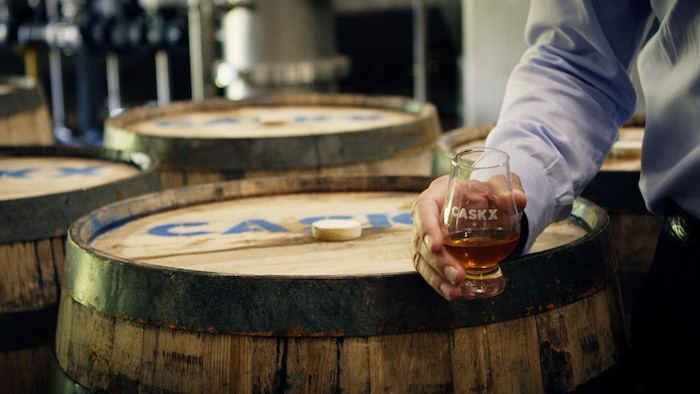The company CaskX is turning its sights to bourbon as the next big investment subject.
Like stocks and bonds before, those collecting valuable spirits are turning to whiskey, and specifically bourbon, for investment.
As technology evolves, it’s now easier than just a year ago for investors to get their hands on shares of rare and fine spirits previously reserved for distillers and super collectors.
CaskX, a Los Angeles-based investment company, first proved this model with Scotch, and last year turned their attention to bourbon as they continue to point qualified investors to this piece of the fastest growing category in the spirits industry.
CaskX CEO Jeremy Kasler visited with The Whiskey Wash and offered insight into how high-net-worth individuals can gain access, particularly since the barrier to entry for whisk(e)y investing has been traditionally high.
Long-standing conventions in the industry dictated that casks could only be sold to private individuals in order to provide the cashflow that distilleries needed, meaning investment was really only open to insiders, large dealers, and institutional buyers.

The Whiskey Wash: What about this period of time do you find investor appetite in bourbon and whiskey to be, is it at an all time high?
Jeremy Kasler: The appetite for bourbon as an alternative investment is certainly at an all-time high due to two major factors.
The first factor is an increased desire among investors to diversify their holdings with tangible assets. With the continued uncertainty surrounding traditional financial markets and the volatility found in new asset classes, such as cryptocurrency, investors are drawn to the relative safety offered by an investment in bourbon barrels. In stark contrast to most types of investments, bourbon barrels are a physical asset that have real intrinsic value – each barrel will eventually be consumed.
The second factor is surging demand for bourbon across international markets. At the moment there are more than 10 million barrels of bourbon aging in Kentucky alone, yet distilleries still aren’t able to keep up with demand. If you take a visit along the Bourbon Trail, this growth can be seen as distilleries are investing big in expanded production and warehousing facilities. Investors who recognize the growth of the market naturally want to find a way to capitalize themselves and investing in bourbon barrels offers them this opportunity.
TWW: How does one become a private, certified investor? And how does one do that with CaskX?
JK: Due to CaskX’s commitment to offering bourbon barrel investments in an SEC-compliant manner, investors must meet the accredited investor requirements as defined by the SEC. Investors who meet these requirements can open a CaskX account and gain access to current investment offerings.
TWW: In the investing world of stocks, bonds, classic cars and real estate, where does bourbon fit in as far as desirability?
JK: Barreled bourbon and Scotch whisky casks have grown to become more than just a niche offering. Today, barreled spirits are considered a mainstream investment product that offer a powerful alternative to other tangible assets such as wine, art, diamonds and cars.
The most intriguing aspect of bourbon barrels as an investment product is the fact that the liquid contained within continues to get better with time. Whereas most tangible assets remain the same, or even depreciate, barrels of bourbon naturally get better with time.
Historically, a bourbon that has matured for 6, 8 or even 10 years has commanded a significantly higher price point than bourbon which has only been aged a brief period. Investors can purchase newly-distilled spirit for a fraction of the price of well-matured bourbon, and stand to reap the profit as that distillate is transformed over a period of years.
TWW: How did the lifting of the EU tariffs help the world of bourbon investing?
JK: Fortunately for bourbon producers, the short-term impact of the EU tariffs were offset by strong continued growth domestically over the past three years. However, removing the tariffs is likely to result in a 30-50% increase in exports to the EU in 2022, adding further demand to the already constrained supply of bourbon. As distilleries seek to increase output, investors can serve an important role in providing the financial resources needed to expand production capabilities and stand to be rewarded for their investment as the barreled bourbon becomes increasingly scarce.
TWW: How does your average investor start the process?
JK: Investors start by opening an account with CaskX. After an account is opened, clients speak with an advisor about their individual investment objectives, desired holding period, risk tolerance and overall budget in order to make recommendations accordingly. When a suitable investment offering is identified and acquired, the investor is provided with full documentation of their purchase along with being able to access their portfolio from a web-based portal.
TWW: How has CaskX done with the earlier run at Scotch investment?
JK: Scotch whisky casks remain a solid alternative asset for many investors and CaskX remains bullish on the industry. To date, every investor who has purchased Scotch whisky casks from CaskX has observed an increase in the value of their holdings. CaskX’s entry into barreled bourbon offerings was a result of careful analysis of the bourbon market and the desire among investors to access these investments. While the Scotch whisky industry has already observed a period of mass expansion and growth, the bourbon industry is only just now entering a period of rapid growth that is projected to parallel or even exceed that of Scotch whisky.








